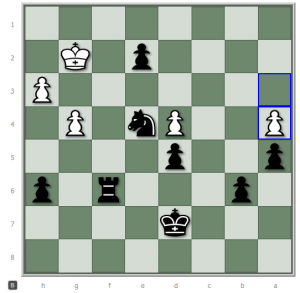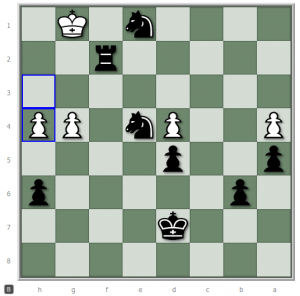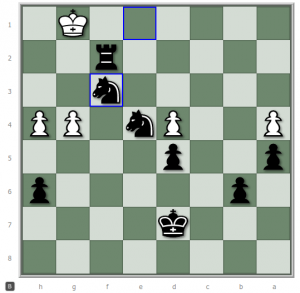
I had achieved a decisive advantage against my regular opponent in a recent “over the board” game of chess, but he was hanging in there and not resigning, even though I was about to promote my pawn (see diagram, left).
There were just a few minutes left on the clock, so perhaps he was hoping to survive until the flag dropped, but at best it was a forlorn hope.
The game could be easily finished off in a couple of moves by Black promoting the e2 pawn to a queen and then moving the rook to f2, so this game is not really a perfect illustration of the title of this blog post, but what happened in this game did make me think about those occasions when it can actually be better to promote the pawn to a knight instead of a queen.
In this game, however, if Black promotes his pawn to a queen, even if White tries to avoid being mated in two by advancing the h pawn to h4, giving his king access to h3, mate is only delayed by one move:

… e8Q
h4 rf2+
Kh3 Qh1#
Nevertheless, a prettier ending suggested itself and so I promoted my pawn to a knight instead, which immediately placed the white king in check, with just three options (K-h2, K-h1, or K-g1).
Sometimes, promoting a pawn to a knight can deliver a decisive advantage, either by checking the king or by forking, or even in some cases by defending a vulnerable piece that would not be defended by promoting to a queen.
Unlike other “underpromotions” (i.e. promoting a pawn to a bishop or a rook instead of to a queen), promoting to a knight means you are promoting your pawn to a piece that does share any movement characteristics with the queen at all, and therefore brings something different to the board.
 A rook shares the queens horizontal and vertical movements, while a bishop shares the queen’s diagonal movements, but is limited to a single colour whereas a queen can take a move to switch from black to white squares. A knight, on the other hand can hop to a square that the queen, starting on the same square as the knight, would not be able to cover. So, while promoting to a bishop or a rook is really just for show, there can be a real purpose behind a knight promotion.
A rook shares the queens horizontal and vertical movements, while a bishop shares the queen’s diagonal movements, but is limited to a single colour whereas a queen can take a move to switch from black to white squares. A knight, on the other hand can hop to a square that the queen, starting on the same square as the knight, would not be able to cover. So, while promoting to a bishop or a rook is really just for show, there can be a real purpose behind a knight promotion.
Incidentally, promoting to a minor piece (such as a knight, bishop or rook) means that it is quite possible for a player to have three (or even more) of the same minor piece on the board at the same time, and according to Gerald Abrahams,
There has indeed, been a famous win, King and three Knights against King and one Knight.
Teach Yourself Chess, (1975 edition), p. 19
 In the event, after I promoted my pawn to a knight and checked White’s king, my opponent moved his king to g1. I responded by moving my rook up the file to f2 where it was protected by the knight on e4.
In the event, after I promoted my pawn to a knight and checked White’s king, my opponent moved his king to g1. I responded by moving my rook up the file to f2 where it was protected by the knight on e4.
With few options available, and still not resigning, White advanced his pawn to h4, and checkmate swiftly followed with two knight moves:
… Nf3+
Kh1 Ng3#
